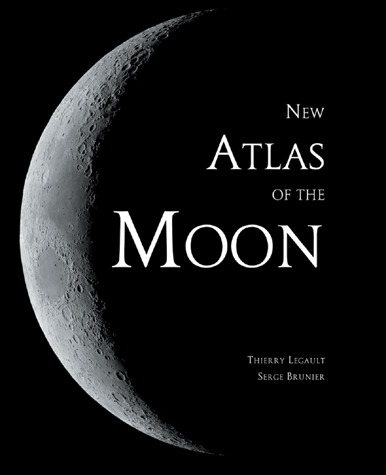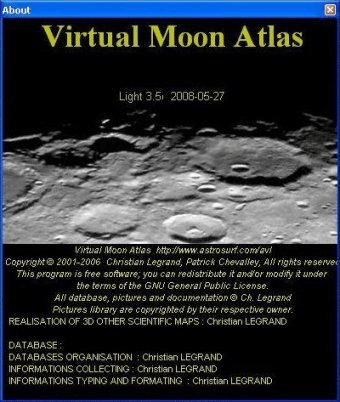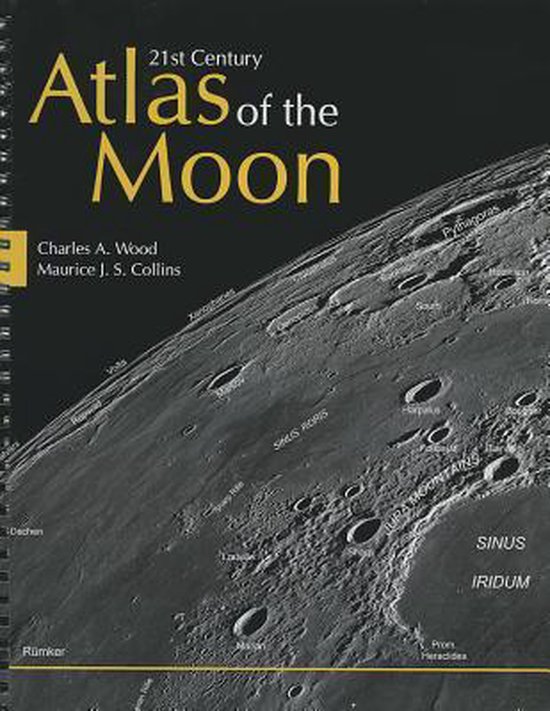1:1 Million-Scale Maps of the Moon
Virtual Moon Atlas has been offering an exceptional observation and study center of the Moon for years. After several years developing it, now we find a more advanced version featuring more options and more powerful than ever. Atlas is an inner moon of Saturn, orbiting around the outer edge of Saturn's A Ring. Like Pan, Atlas has a distinctive flying saucer shape created by a prominent equatorial ridge not seen on the other small moons of Saturn. Cassini images revealed in 2004 that a temporary faint ring of material with the orbit of Atlas.
Please choose the quadrangle you would like to view. Files are in Adobe Portable Document Format (PDF), and you must have the free Adobe Acrobat Reader installed on your system to view them.
Index map courtesy of Ben Bussey, adapted from The Clementine Atlas of the Moon, Cambridge University Press.
Introduction (February 13, 2013):
The purpose of the lunar maps presented here is to provide an up-to-date and comprehensive depiction of lunar nomenclature. As new names are approved, they are added to the maps so users have access to the most recent changes in lunar nomenclature.
Sarah Moon is a French fashion photographer who rose to prominence in London during the 1970s. View Sarah Moon’s 180 artworks on artnet. Find an in-depth biography, exhibitions, original artworks for sale, the latest news, and sold auction prices. The Atlas of Moons. Stay Informed For $2.99/month. This content is available exclusively for National Geographic subscribers. Subscribe to get unlimited access to National Geographic.
The International Astronomical Union (IAU) is the internationally recognized authority for assigning nomenclature to planetary surface features. The lunar maps on this web site are based on the information contained in the Gazetteer of Planetary Nomenclature, which is a dynamic listing of IAU-approved planetary surface feature names. The Astrogeology Science Center of the U.S. Geological Survey maintains the Gazetteer of Planetary Nomenclature on behalf of the IAU with funding from the National Aeronautics and Space Administration (NASA).
At the time of this writing, there are 9,003 IAU-approved names in use on the Moon (not including names that have been dropped but are retained in the gazetteer for reference). These names are of various feature types: catenae, craters, dorsa, fossae, lacūs, landing site names, maria, montes, oceanus, paludes, planitiae, promontoria, rimae, rupēs, lettered craters (called 'satellite features' in the gazetteer), sinūs, and valles. The maps shown here include only names that are formally approved by the IAU and are currently in use. The lettered crater names included in the Gazetteer of Planetary Nomenclature, and therefore in this atlas, are found in the definitive source 'NASA Catalogue of Lunar Nomenclature' (NASA Reference Publication 1097). Over the decades, many informal names have been used on the Moon and some IAU-approved names have been officially changed. Informal names and names that have been changed are not shown. Cross references between these old and new names have been noted in the 'Additional Information' field of the gazetteer. This is not a complete record of cross references, only those discovered during the research for these maps.
These maps are kept up-to-date. As new names are approved by the IAU, they will be added to the maps. If a name is dropped, it will be removed, and if a feature is renamed, the new name will replace the old name. Whenever there is a change to the lunar portion of the Gazetteer of Planetary Nomenclature, that change will be shown on the corresponding map, and a revision date will be added to the map. Changes to the gazetteer listings are recorded in the 'News' section on the title page of the gazetteer. The IAU name approval process is also described in the gazetteer.

Questionable Names:
Substantial effort has been made to accurately place each name. The location of each name was examined, sometimes in multiple sources, before inclusion. The locations of some feature names were questionable because the names are not shown in the sources, or there is conflicting information in the sources. These questionable cases were presented to lunar nomenclature expert Ewen Whitaker, who was able to provide a definitive answer in most instances. For the remaining few questionable features, educated guesses were made based on information in the sources, and coordinate and size information in the database.
The locations of the following lettered craters were verified by Ewen Whitaker. The locations differ from what is shown in some printed atlases and maps, but Whitaker's location information is given precedence.
- Barbier K (LAC 103)
- Bolyai Q (LAC 117)
- Büshing F (LAC 113)
- Büshing H (LAC 113)
- Buys-Ballot Q (LAC 50)
- Condorcet N (LAC 63)
- Dubyago G (LAC 62)
- Cusanus E (LAC 5)
- Galvani B (LAC 36)
- Galvani D (LAC 36)
- Galvani G (LAC 36)
- Galvani H (LAC 36)
- Galvani J (LAC 36)
- Gauss J (LAC 28)
- Gay-Lussac N (LAC 58)
- Geiger K (LAC 103)
- Gerard F (LAC 22)
- Goldschmidt C (LAC 3)
- Haret Y (LAC 132)
- Hayn C (LAC 5)
- Hayn T (LAC 5)
- Hilbert A (LAC 100)
- Houzeau P (LAC 107)
- Houzeau Q (LAC 107)
- Jenner Y (LAC 116)
- Krasnov C (LAC 91)
- Krasovskiy T (LAC 68)
- La Pérouse A (LAC 81)
- Lodygin M (LAC 106)
- Lyot T (LAC 115)
- Maurolycus N (LAC 113)
- Milichius E (LAC 58)
- Numerov G (LAC 142)
- Perenago Z (LAC 54)
- Petermann A (LAC 5)
- Petermann X (LAC 5)
- Petermann Y (LAC 5)
- Pikel’ner S (LAC 130)
- Pingré N (LAC 135)
- Pingré Z (LAC 135)
- Poncelet P (LAC 1)
- Purkyně U (LAC 82)
- Repsold A (LAC 10)
- Repsold W (LAC 10)
- Riccioli K (LAC 73)
- Rumford F (LAC 105)
- Schorr B (LAC 99)
- Schrödinger G (LAC 140)
- Schubert A (LAC 63)
- Schwabe X (LAC 5)
- Tikhomirov (LAC 49)
- Valier P (LAC 68)
- Vernadsky U (LAC 47)
- Wöhler E (LAC 113)
- Xenophanes F (LAC 10)
- Zeno H (LAC 28)
Name Placement and Font:
Placement of names on the maps follows USGS cartographic standards. Names are placed inside craters if they fit comfortably within the feature. If a name does not fit inside the crater, the next preferable location is just outside the crater and to the right of it. If another name or feature precludes this positioning, the name is placed elsewhere outside the feature in a readable spot. For every name that is placed outside of a crater, a dot is placed in the center of the crater so there is no question which crater the name is associated with. For non-crater features, names are placed alongside or on the features. Some craters are too small to be seen on the images; in these cases, a note has been added indicating a larger-scale map that shows the feature, and where possible, a link to the map has been added.
In most publications that include lettered craters, the 'parent' portion of the name has been omitted because of limited space. For instance, Abenezra A is portrayed as just 'A.' Different methods have been used over the years to show which parent crater the satellite crater belongs with. Traditionally, letters are placed on the side of the satellite crater that is closest to the parent crater, but at least one atlas uses font size to differentiate these features. These methods help the reader to associate the lettered crater with the correct parent crater, but the association is not always clear. The situation is especially unclear in regions of the Moon where there are many of these lettered craters, or when the parent crater is located on a different quadrangle than the satellite crater. For the maps presented here, the full name of each lettered crater has been used in every case. For instance, the name 'Abenezra A' will be shown next to the feature, not just 'A,' so there is no question about which parent crater the satellite crater belongs with. Satellite crater names are shown in upper and lower case letters; all other crater names are shown in upper case letters.
Font color was chosen for readability only, and font size varies depending on the number of names in a region; in crowded areas, the font size is smaller. The user should not expect to see all of the names on a map by viewing at screen size or printing at page size. Since these maps are digital products, the intention is for the user to change magnification to examine the named features in an area of interest. The maps can be printed at page scale or document scale, which varies by map but is usually about 30 inches by 30 inches.
Some IAU-approved names have alternate spellings shown in parentheses (see the list of lunar crater names in the Gazetteer of Planetary Nomenclature). The preferred spellings have been used on these maps.
The boundaries of some features are not clear because the feature has been degraded or the image base does not show the feature clearly. In these cases, approximate boundaries have been drawn with dotted lines.
Image Base:
The Lunar Astronautical Chart (LAC) series divides the Moon into 144 quadrangles (36 Mercator, 106 Lambert Conformal, and 2 Polar Stereographic quadrangles). The LAC chart format was chosen for this set of maps because the LAC charts were widely distributed and used, they are available online at the Lunar and Planetary Institute, and the relatively small surface area covered by each chart provides a file size that is easily downloaded and at the same time provides enough detail to portray the nomenclature.
The Lunar Reconnaissance Orbiter Camera (LROC) Wide Angle Camera (WAC) Global Morphologic Map (100 meters per pixel) is used as the base for this map series.
Previous Versions of this Atlas:
The current atlas supersedes the two previous versions of the 1:1 million-scale atlas of the Moon. One of the previous versions used the USGS shaded relief and color-coded topography as an image base and the other used the USGS Lunar Orbiter mosaic (Becker et al., 2008) as the image base. These two versions are no longer supported; URLs that linked to these versions have been redirected to the current atlas with the LROC WAC image base.Acknowledgements:
Special thanks go to Ewen Whitaker, who graciously and promptly consulted his extensive archives to answer complicated questions about the locations of named features. Scott Akins and Mark Bailen of the USGS (and Ryan Raub, Deborah Soltesz and Brian Peck formerly of the USGS) are responsible for the design and function of the web pages. Bonnie Redding, also of the USGS, provided image processing and cartographic skills. Special thanks also to the LROC and LRO teams for their hard work and dedication, which resulted in the beautiful image base used in this atlas. The members of the IAU’s Working Group for Planetary System Nomenclature and its Task Groups have worked since the early 1970s to provide a clear system of planetary nomenclature that represents cultures and countries from all regions of Earth. This work was funded by the National Aeronautics and Space Administration, through the Planetary Geology and Geophysics Program.
Feedback:
Please send comments regarding these maps, or planetary nomenclature in general, to Jennifer Blue at jblue@usgs.gov.
Sources:
Atlases and Books:
Andersson, L.E., and E.A. Whitaker, NASA Catalogue of Lunar Nomenclature, NASA Reference Publication 1097, October 1982.
Bussey, B. and P.D. Spudis, The Clementine Atlas of the Moon, Cambridge University Press, Cambridge, 2004.
Byrne, Charles J., Lunar Orbiter Photographic Atlas of the Near Side of the Moon, Springer, London, 2005.
Byrne, Charles J., The Far Side of the Moon, A Photographic Guide, Springer, London, 2008.
Gutschewski, G.L., D.C. Kinsler, and E. Whitaker, Atlas and Gazetteer of the Near Side of the Moon, NASA SP-241, Washington, D.C., 1971.
Lunar and Planetary Institute, Digital Lunar Orbiter Photographic Atlas of the Moon.
Rükl, A., Astronomy Atlas of the Moon, Kalmback Books, Wisconsin, 1990.
Whitaker, E.A., Mapping and Naming the Moon, Cambridge University Press, Cambridge, 1999.
Whitaker, E.A., G.P. Kuiper, W.K. Hartmann, and L.H. Spreadley, Rectified Lunar Atlas, Supplement Number Two to the USAF Lunar Atlas.
Wilhelms, Don E., The Geologic History of the Moon, U.S. Geological Survey Professional Paper 1348, U.S. Government Printing Office, Washington, D.C., 1987.
Maps:
Moon Atlas 3d
Color-Coded Topography and Shaded Relief Maps of the Lunar Hemispheres, 1:10,000,000, USGS I-2769, 2002, http://geopubs.wr.usgs.gov/i-map/i2769/.
Lunar Craters Map
Lunar Astronautical Chart (LAC) Series, 1:1,000,000, Aeronautical Chart and Information Center, Washington, D.C., 1962-1967.
Lunar Earthside, Farside, and Polar Charts (LMP-1, LMP-2, and LMP-3), 1:5,000,000, Astronautical Chart and Information Center, Washington, D.C., 1970. Qlogic network & wireless cards driver download for windows 10.
Lunar Equatorial Zone Mosaics (Earthside, Farside, Western Limb, Eastern Limb), 1:2,500,000, Department of Defense, 1969.
Lunar Map (LM) Series, 1:1,000,000, Defense Mapping Agency, St. Louis, 1976-1978.
Lunar Planning Charts (LOC-1, LOC-2, LOC-3, LOC-4), 1:2,750,000, Aeronautical Chart and Information Center, Washington, D.C., 1971.
Lunar Topographic Orthophoto Map (LTO) Series, 1:250,000, Defense Mapping Agency, Washington, D.C., 1970s.
Lunar Topophoto Map Series, 1:50,000, Defense Mapping Agency, Washington, D.C., 1970s.
Map Showing Relief and Surface Markings of the Lunar Far Side, 1:5,000,000, USGS I-1218-A, 1980.

Map Showing Relief and Surface Markings of the Lunar Polar Regions, 1:5,000,000, USGS I-1326-B, 1981.
Moon Atlas
Shaded Relief and Surface Markings of the Lunar Near Side, 1:5,000,000. USGS I-2276, 1992.
References:

Arthur, D.W., et al., The System of Lunar Craters, Quadrant 1, Communications of the Lunar and Planetary Laboratory, Vol. 2, Number 30, 1963.
Arthur, D.W., et al., The System of Lunar Craters, Quadrant 2, Communications of the Lunar and Planetary Laboratory, Vol. 3, Number 40, 1964.
Arthur, D.W., et al., The System of Lunar Craters, Quadrant 3, Communications of the Lunar and Planetary Laboratory, Vol. 3, Number 50, 1965.
Arthur, D.W., et al., The System of Lunar Craters, Quadrant 4, Communications of the Lunar and Planetary Laboratory, Vol. 5, Number 70, 1966.
Becker, T., L. Weller, L. Gaddis, 2008, Lunar Orbiter Mosaic of the Moon, LPS XXXIX, abs. #2357, http://www.lpi.usra.edu/meetings/lpsc2008/pdf/2357.pdf.


Detailed Map Of The Moon
Wood, Chuck. 'The-Moon Wiki.' 8 May 2010. Web. 25 August 2010. http://the-moon.us/wiki/Introduction.
